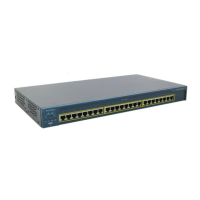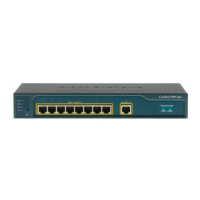29-10
Catalyst 2950 and Catalyst 2955 Switch Software Configuration Guide
78-11380-12
Chapter 29 Configuring QoS
Configuring Auto-QoS
Configuring Auto-QoS
Note This feature is available only if your switch is running the EI.
You can use the auto-QoS feature to simplify the deployment of existing QoS features. Auto-QoS makes
assumptions about the network design, and as a result, the switch can prioritize different traffic flows
and appropriately use the egress queues instead of using the default QoS behavior (the switch offers
best-effort service to each packet regardless of the packet contents or size and sends it from a single
queue).
When you enable auto-QoS, it automatically classifies traffic based on the traffic type and ingress packet
label. The switch uses the resulting classification to choose the appropriate egress queue.
You use auto-QoS commands to identify ports connected to Cisco IP Phones and to devices running the
Cisco SoftPhone application. You also use the commands to identify ports that receive trusted traffic
through an uplink. Auto-QoS then performs these functions:
• Detects the presence or absence of IP phones
• Configures QoS classification
• Configures egress queues
These sections describe how to configure auto-QoS on your switch:
• Generated Auto-QoS Configuration, page 29-10
• Effects of Auto-QoS on the Configuration, page 29-12
• Configuration Guidelines, page 29-13
• Upgrading from a Previous Software Release, page 29-13
• Enabling Auto-QoS for VoIP, page 29-14
Generated Auto-QoS Configuration
When auto-QoS is enabled, it uses the ingress packet label to classify traffic and to configure the egress
queues as described in Table 29-2.
Table 29-2 Traffic Types, Packet Labels, and Egress Queues
VoIP
1
Data
Traffic
1. VoIP = voice over IP
VoIP Control
Traffic
Routing Protocol
Traffic
STP BPDU
2
Traffic
2. BPDU = bridge protocol data unit
Real-Time
Video Traffic All Other Traffic
DSCP 46 24, 26 48 56 34 –
CoS 5 3 6 7 4
CoS-to-Queue
Map
5 3, 6, 7 4 2 0, 1
Egress Queue 1% WRR
(queue 4)
70% WRR (queue 3) 20% WRR
(queue 2)
20% WRR
(queue 2)
10% WRR
(queue 1)

